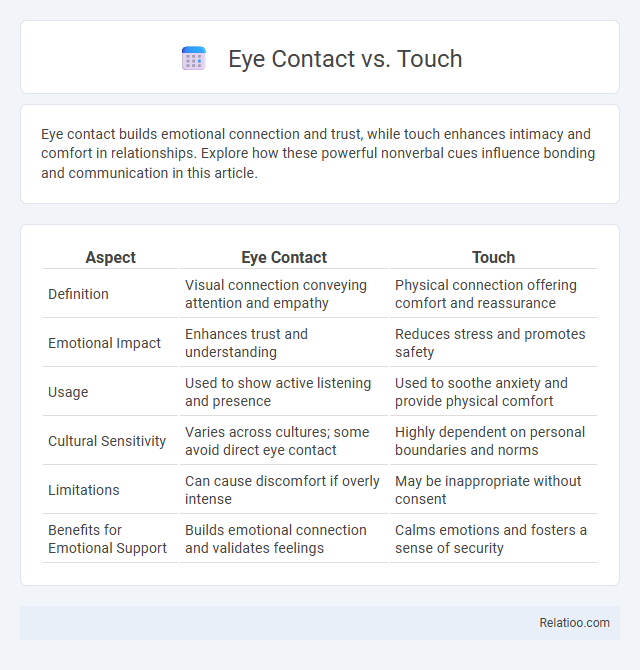Eye contact builds emotional connection and trust, while touch enhances intimacy and comfort in relationships. Explore how these powerful nonverbal cues influence bonding and communication in this article.
Table of Comparison
| Aspect | Eye Contact | Touch |
|---|---|---|
| Definition | Visual connection conveying attention and empathy | Physical connection offering comfort and reassurance |
| Emotional Impact | Enhances trust and understanding | Reduces stress and promotes safety |
| Usage | Used to show active listening and presence | Used to soothe anxiety and provide physical comfort |
| Cultural Sensitivity | Varies across cultures; some avoid direct eye contact | Highly dependent on personal boundaries and norms |
| Limitations | Can cause discomfort if overly intense | May be inappropriate without consent |
| Benefits for Emotional Support | Builds emotional connection and validates feelings | Calms emotions and fosters a sense of security |
Understanding Eye Contact and Touch
Eye contact serves as a powerful nonverbal cue that conveys attention, confidence, and emotional connection, influencing interpersonal trust and communication effectiveness. Touch, another critical component of nonverbal communication, varies in meaning across cultures and contexts, often signaling empathy, support, or dominance. Understanding the nuances of eye contact and touch enhances the ability to interpret social interactions and build stronger relational bonds.
Cultural Significance of Eye Contact and Touch
Eye contact holds varied cultural significance, symbolizing respect and attentiveness in Western societies while potentially indicating confrontation or disrespect in some Asian and African cultures. Touch carries diverse meanings, serving as a form of warmth and connection in Latin American and Mediterranean cultures but often regarded as intrusive in East Asian and Northern European contexts. Understanding these cultural nuances is essential for effective nonverbal communication, enhancing interpersonal interactions across global settings.
Psychological Impact of Eye Contact
Eye contact plays a crucial psychological role by fostering trust, enhancing emotional connection, and signaling attentiveness during interactions. Unlike touch or other nonverbal cues, eye contact directly activates brain regions associated with social cognition and empathy, strengthening your interpersonal bonds. Its sustained presence can reduce anxiety and create a sense of security, making it a powerful tool for communication.
Emotional Power of Touch
Touch has a profound emotional power that surpasses eye contact and other forms of nonverbal communication by triggering the release of oxytocin, fostering trust and bonding. Your ability to use touch appropriately can convey empathy, comfort, and reassurance more effectively than words or gaze alone. Understanding the emotional significance of touch enhances interpersonal connections and supports emotional well-being.
Eye Contact vs Touch in Communication
Eye contact and touch serve distinct yet powerful roles in communication; eye contact conveys attentiveness, confidence, and emotional connection through visual engagement, while touch communicates warmth, reassurance, and intimacy by physical presence. Your ability to balance these nonverbal cues enhances trust and understanding, as eye contact fosters cognitive connection, whereas touch often triggers emotional resonance. Effective communicators recognize when to use eye contact to establish focus and touch to reinforce empathy in interpersonal interactions.
Nonverbal Cues: Eye Contact vs Touch
Nonverbal communication relies heavily on eye contact and touch as key cues conveying emotions and intentions. Eye contact can express confidence, attention, or social connection, while touch provides comfort, reassurance, or intimacy depending on context and cultural norms. Understanding these nonverbal signals enhances your ability to interpret unspoken messages effectively in personal and professional interactions.
Trust and Intimacy: Which Connects Better?
Eye contact fosters a powerful sense of trust and intimacy by creating direct, honest connections between individuals, making your interactions feel genuine and engaged. Touch, when appropriate, enhances emotional closeness by conveying warmth and security beyond words, reinforcing personal bonds. Nonverbal communication as a whole combines these elements, but eye contact often serves as the strongest initial bridge for building trust and deepening intimate relationships.
Boundaries and Appropriateness
Eye contact, touch, and nonverbal communication each play crucial roles in conveying messages but vary significantly in boundaries and appropriateness depending on cultural norms and personal comfort levels. Your ability to read and respect these cues can prevent misunderstandings and foster positive interactions by maintaining clear boundaries. Establishing appropriate limits in eye contact, physical touch, and body language ensures respectful communication and mutual trust.
Eye Contact and Touch in Professional Settings
Eye contact in professional settings conveys confidence, attentiveness, and trustworthiness, making it a powerful tool for effective communication and relationship building. Touch, such as a firm handshake, can reinforce positive impressions and create a sense of connection, but should be used cautiously respecting personal boundaries and cultural differences. Your ability to balance eye contact and appropriate touch enhances nonverbal communication, fostering stronger professional interactions and rapport.
Choosing the Right Approach: Eye Contact or Touch?
Choosing between eye contact and touch depends on the context, cultural norms, and the nature of your relationship, as each gesture carries distinct nonverbal meanings. Eye contact conveys confidence, attention, and sincerity, making it ideal for professional and social interactions where trust and engagement are crucial. Touch can express warmth and empathy but requires sensitivity to personal boundaries and cultural differences to ensure your message is received positively.

Infographic: Eye Contact vs Touch
 relatioo.com
relatioo.com